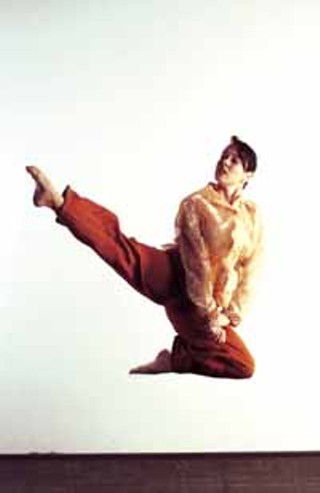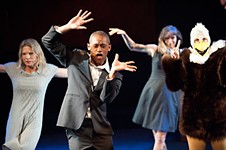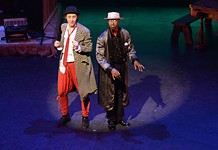Ariel Dance Theatre in Concert
Local Arts Reviews
Reviewed by Robert Faires, Fri., Dec. 28, 2001

Ariel Dance Theatre In Concert: Jump into the Fire
Ducloux Hall, Armstrong Opera CenterDecember 9
"Step into love's pure flame," sang soprano Cheryl Parrish with mesmerizing authority as she walked around the center of Ducloux Hall. Within the perimeter of the circle marked out by her steps were six dancers clothed in varying shades of scarlet, their fluid bodies extending and arching, compressing and turning, moving inward and outward in unpredictable patterns, like tongues of fire. As they danced "The Silent Circle," the 25-minute closing work in Ariel Dance Theatre's In Concert program, we could see the flame she was singing about, and it was enticing in that enigmatic way that fire is, so bright and intense and somehow not quite of this world, so that you want to be part of it even if doing so is to immolate yourself.
Not that there was any true danger in this latest program from the ever-energetic, always searching, always stretching herself Andrea Ariel and her well-chosen company of collaborators. But there was the tension that underlies something beautiful and dangerous, something you're drawn to but feel threatened by. The original music composed by Peter Stopschinski and Graham Reynolds was often thick with foreboding: dark, heavy piano chords, dissonance, stinging percussion. Then there was Brandon Ariel's installation above the playing space, a mass of metal rods twisted and intertwined into a giant jagged ring that hung suspended over the dancers like a great crown of thorns that could crash down on them at any time. And within the dances themselves were sharp, ominous movements: the confined steps, suggestive of a military march, in "The Patriot Priest," the erratic, frenetic jerks of the body in "Body Graph I," the arms arcing and slicing the air like scythes in "Boxed In." These things contributed to a sense of something threatening in the air, a repressive force -- a totalitarian regime, perhaps, or a numbing conformity.
Still, within this ominous atmosphere there was a beauty. Sometimes it was a terrible beauty, as in the music, which retained a kind of majesty even at its harshest, or in the dance moves, which dissected the air with a captivating precision. But sometimes it was a more open-hearted kind, as with Parrish's exquisite voice, which filled the hall like a golden wind. Stopschinski's score for "Body Graph I," with its sinuous piano and bubbly vibraphone, at times seemed like the soundtrack of some lost spy movie from the Sixties, luscious and sexy, and when she slowed herself down, Ariel took on the slinky, sultry moves of a Bond girl. In "The Patriot Priest," choreographed by Ariel, Angel Mendez, and Jim Chappeleaux, and danced by Chappeleaux, the rigid march around the edges of a box of light was periodically interrupted by explosions of loose, unfettered whirling, suggesting the beauty of freedom, the individual spirit, even religious ecstasy. In "Boxed-in," the space beneath the ring of metal became an arena in which Ariel, Chappeleaux, and their fellow dancers -- Ellen Bartel, Whitney Hocke, Cecilia Jones, and Nancy Moran -- conducted a freewheeling exchange of fast-paced, exuberant physical moves. They would take turns rushing into the circle and dancing, moving in only when another dancer or dancers were moving out, as if they were playing some variation of Red Rover or musical chairs. With the liveliness of the movement, it gave the dance a sense of exhilaration.
There is, however, a beauty that was evident in the program that is less easily described: the beauty of collaboration. Something in this combination of artists, pulled together from various disciplines, seemed to be feeding all of them, leading them to expand their creative limits, to give to the other artists something they could play off of, build off of. The feeling of exchange in the air, exchange among artists, was as beautiful and exhilarating as the give-and-take among the dancers in "Boxed-in." Rich creative collaborations generate heat and light, and there was much of that in Ducloux Hall that day. Perhaps we were in love's pure flame all along.










